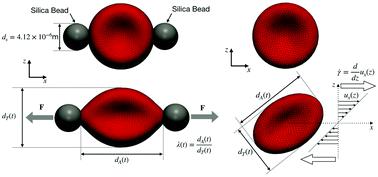当前位置:
X-MOL 学术
›
Soft Matter
›
论文详情
Our official English website, www.x-mol.net, welcomes your
feedback! (Note: you will need to create a separate account there.)
On the effects of membrane viscosity on transient red blood cell dynamics.
Soft Matter ( IF 2.9 ) Pub Date : 2020-06-01 , DOI: 10.1039/d0sm00587h Fabio Guglietta 1 , Marek Behr 2 , Luca Biferale 3 , Giacomo Falcucci 4 , Mauro Sbragaglia 3
Soft Matter ( IF 2.9 ) Pub Date : 2020-06-01 , DOI: 10.1039/d0sm00587h Fabio Guglietta 1 , Marek Behr 2 , Luca Biferale 3 , Giacomo Falcucci 4 , Mauro Sbragaglia 3
Affiliation

|
Computational Fluid Dynamics (CFD) is currently used to design and improve the hydraulic properties of biomedical devices, wherein the large scale blood circulation needs to be simulated by accounting for the mechanical response of red blood cells (RBCs) at the mesoscale. In many practical instances, biomedical devices work on time-scales comparable to the intrinsic relaxation time of RBCs: thus, a systematic understanding of the time-dependent response of erythrocyte membranes is crucial for the effective design of such devices. So far, this information has been deduced from experimental data, which do not necessarily adapt to the broad variety of fluid dynamic conditions that can be encountered in practice. This work explores the novel possibility of studying the time-dependent response of an erythrocyte membrane to external mechanical loads via mesoscale numerical simulations, with a primary focus on the detailed characterisation of the RBC relaxation time tc following the arrest of the external mechanical load. The adopted mesoscale model exploits a hybrid Immersed Boundary-Lattice Boltzmann Method (IB-LBM), coupled with the Standard Linear Solid (SLS) model to account for the RBC membrane viscosity. We underscore the key importance of the 2D membrane viscosity μm to correctly reproduce the relaxation time of the RBC membrane. A detailed assessment of the dependencies on the typology and strength of the applied mechanical loads is also provided. Overall, our findings open interesting future perspectives for the study of the non-linear response of RBCs immersed in time-dependent strain fields.
中文翻译:

关于膜粘度对瞬时红细胞动力学的影响。
计算流体动力学(CFD)当前用于设计和改善生物医学设备的水力特性,其中需要通过考虑中尺度的红细胞(RBC)的机械响应来模拟大规模的血液循环。在许多实际情况下,生物医学设备的工作时间与RBC的固有弛豫时间相当:因此,对红细胞膜的时间依赖性响应的系统了解对于此类设备的有效设计至关重要。到目前为止,该信息是从实验数据中推导出来的,这些数据不一定适应实际中可能遇到的各种流体动力学条件。这项工作探索了研究红细胞膜对外部机械负荷的时间依赖性反应的新可能性通过中尺度数值模拟,主要集中在阻止外部机械负载后RBC弛豫时间t c的详细表征。采用的中尺度模型利用混合浸入边界格子Boltzmann方法(IB-LBM),结合标准线性固体(SLS)模型来解决RBC膜的粘度问题。我们强调的至关重要的2D膜的粘度μ米正确再现RBC膜的松弛时间。还提供了对所施加机械负载的类型和强度的依赖性的详细评估。总体而言,我们的发现为浸入时间依赖性应变场的RBC的非线性响应研究提供了有趣的未来前景。
更新日期:2020-07-08
中文翻译:

关于膜粘度对瞬时红细胞动力学的影响。
计算流体动力学(CFD)当前用于设计和改善生物医学设备的水力特性,其中需要通过考虑中尺度的红细胞(RBC)的机械响应来模拟大规模的血液循环。在许多实际情况下,生物医学设备的工作时间与RBC的固有弛豫时间相当:因此,对红细胞膜的时间依赖性响应的系统了解对于此类设备的有效设计至关重要。到目前为止,该信息是从实验数据中推导出来的,这些数据不一定适应实际中可能遇到的各种流体动力学条件。这项工作探索了研究红细胞膜对外部机械负荷的时间依赖性反应的新可能性通过中尺度数值模拟,主要集中在阻止外部机械负载后RBC弛豫时间t c的详细表征。采用的中尺度模型利用混合浸入边界格子Boltzmann方法(IB-LBM),结合标准线性固体(SLS)模型来解决RBC膜的粘度问题。我们强调的至关重要的2D膜的粘度μ米正确再现RBC膜的松弛时间。还提供了对所施加机械负载的类型和强度的依赖性的详细评估。总体而言,我们的发现为浸入时间依赖性应变场的RBC的非线性响应研究提供了有趣的未来前景。











































 京公网安备 11010802027423号
京公网安备 11010802027423号